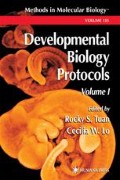Abstract
For almost two decades, introduction of new genes, transgenic technology, has been the source of many new strains of mice that have become valuable tools in various fields of research. More recently, knockout technology has generated a large number of mutant strains. To maintain all these lines and make them available to the scientific community, a strict breeding schedule must be followed. This can quickly become a financial burden, even for large institutions with adequate funding. Alternatively, cryopreservation offers the means to maintain mouse lines in the smallest space available, thereby reducing the requirements of time, energy, and funds. Such practices would involve freezing either mouse gametes (1–8), where the lines would be revived through in vitro fertilization, or freezing mouse embryos where the line would be reestablished after recovering the embryos.
Access this chapter
Tax calculation will be finalised at checkout
Purchases are for personal use only
References
Leibo, S. P., DeMayo, F. J., and O’Malley, B. (1991) Production of transgenic mice from cryopreserved ova. Mol. Reprod. Dev. 30, 313–319.
Leibo, S. P. (1992) Techniques for preservation of mammalian germ plasm. Anim. Biotech. 3, 139–153.
Whittingham, D. G. (1977) Fertilization in vitro and development to term of unfertilized mouse oocytes previously stored at −196°C. J. Reprod. Fertil. 49, 89–94.
Fuller, B. J. and Bernard, A. (1984) Successful in vitro fertilization of mouse oocytes after cryopreservation using glycerol. Cryo-Letters 5, 307–312.
Candy, C. J., Wood, M. J., Whittingham, D. G., Merriman, J. A., and Choudhury, N. (1994) Cryopreservation of immature mouse oocytes. Hum. Reprod. 9, 1738–1742.
Songsasen, N., Betteridge, K. J., and Leibo, S. P. (1997) Birth of live mice from oocytes fertilized in vitro with cryopreserved spermatozoa. Biol. Reprod. 56, 143–152.
Tao, J., Du, J., Kleinhans, F. W., Critser, E. S., Mazur, P., and Critser, J. K. (1995) The effect of collection temperature, cooling rate and warming rate on chilling injury and cryopreservation of mouse spermatozoa. J. Reprod. Fertil. 104, 231–236.
Storey, B. T., Thompson, K. A., Richa, J., and Liebhaber, S. A. (1999) Mouse sperm cryopreservation: dialysis addition of cryoprotectant and IVF with direct insemination post-thaw provides promising route to transgene transmission. American Society and Andrology Annual Meeting, Louisville, KY, April 11–13, 1999.
Whittingham, D. G., Leibo, S. P., and Mazur, P. (1972) Survival of mouse embryos frozen to −196°C and −296°C. Science 178, 411–414.
Liehman, P., Tepla, O., and Fulka, J. (1990) Vitrification of mouse 8-cell embryos with glycerol as a cryoprotectant. Folia Biol. 36, 240–251.
Kasai, M., Komi, J. H., Takakomo, A., Tsudera, H., Sakurai, T., and Machida, T. (1990) A simple method for mouse embryo cryopreservation in a low toxicity vitrification solution, without appreciable loss of viability. J. Reprod. Fertil. 89, 91–97.
Scheffen, B., Van Der Zwalen, P., and Massip, A. (1986) A simple and efficient procedure for preservation of mouse embryos by vitrification. Cryo-Letters 7, 260–269.
Rall, W. F. (1987) Factors affecting the survival of mouse embryos cryopreserved by vitrification. Cryobiology 24, 387–402.
Pomeroy, K. O. (1991) Cryopreservation of transgenic mice. Genet. Anal. Tech. Applicat. 8, 95–101.
Advanced Hands-On Workshop on Cryopreservation of Spermatozoa and Embryos. June 11–13, 1993, Indianapolis, IN.
Hogan, B., Beddington, R., Costantini, F., and Lacy, E. (1994) Manipulating the Mouse Embryo: A Laboratory Manual. Cold Spring Harbor Laboratory Press, Cold Spring Harbor, NY.
Author information
Authors and Affiliations
Editor information
Editors and Affiliations
Rights and permissions
Copyright information
© 2000 Humana Press Inc., Totowa, NJ
About this protocol
Cite this protocol
Richa, J. (2000). Cryopreservation of Mouse Embryos. In: Walker, J.M., Tuan, R.S., Lo, C.W. (eds) Developmental Biology Protocols. Methods in Molecular Biology™, vol 135. Humana Press. https://doi.org/10.1385/1-59259-685-1:77
Download citation
DOI: https://doi.org/10.1385/1-59259-685-1:77
Publisher Name: Humana Press
Print ISBN: 978-0-89603-852-3
Online ISBN: 978-1-59259-685-0
eBook Packages: Springer Protocols

